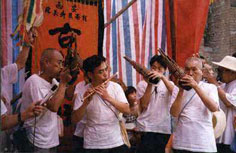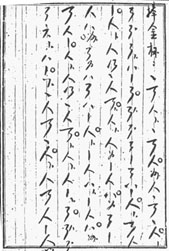Cheng Yu : Research

PhD research topic: Ancient Music of Xi'an

Ancient Xi'an Music is a form of music played played by folk musicians in the area around Xi'an. It is characterised by wind and percussion ensembles led by dizi (bamboo flute) and guanzi (reed pipe). The music has an inseparable relationship with religion (Buddhism and Daoism) and is played only for religious, never commercial, purposes. It is one of the most important surviving types of Chinese music, yet surprisingly has been largely neglected by both performers and researchers. The tradition is at present carried on only by a few elderly musicians.
The highly acclaimed surviving notation (more than 3600 pieces) constitutes a large corpus of ancient Chinese melodies and is in a rare and ancient half-character notation system which is closely linked with the Tang and Song notation systems. It provides important evidence in the search for some of the music that we have lost from the Tang and Song periods.
Xi'an, one of China's most important historical cities, is the site of the glorious Tang (618-907) capital of Chang'an, which was the prosperous Eastern terminus of the Central Asian trade routes. Ancient Xi'an Music has been described as a "living fossil" descended directly from specific musical genres of the Tang and Song (960-1275) periods.
The title of Cheng Yu's doctoral research thesis is "Ancient Music of Xi'an in Contemporary China: Living Fossil or Flowing River". This title reflects the controversy over whether this music has been transmitted unchanged for over a millenium or has undergone significant modification. This relates to Chinese attitudes to tradition and to the changing concepts of the functions and power of music in different eras of China's history. It is an investigation into the inter-relationships between music and its social, historical and religious contexts. The study attempts to argue and discuss the two contending claims towards tradition in China: "living fossil" and "flowing river", and also considers western scholarship on the subject. They are examined through an analysis both of intra-musical (notation, instrumentation and tonal relationships) and extramusical (socio-cultural and religious influences) elements. The research is based largely on the author's extensive field work in Xi'an during 1994, 1995 and 1998. The research should be of interest to a range of scholars in ethnomusicology, anthropology, history, sinology and perhaps also to performing artists. She completed her PhD and graduated in 2005.
